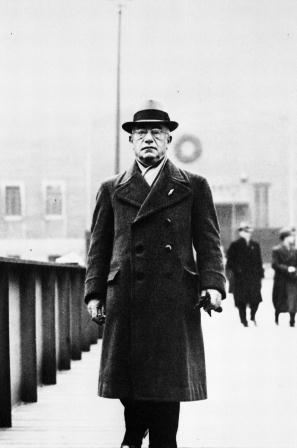 Brit Shalom was founded in 1925, a little after the 14th Zionist Congress, in the home of Arthur Ruppin in Jerusalem. Ruppin, one of the chief organizers of the Jewish settlement in Palestine, underwent several ideological changes in his life regarding the Arab question. In his early years as a Zionist his ideal brand of coexistence was that of a "cultural melting pot", somewhat similar to the vision expressed in "Altneuland' by Herzl. In the following years, as he grew more familiar with the reality in Palestine, he changed his stance, and came to believe that a reaffirmation and revival of both cultures and a mutual national fulfillment of both people would be necessary to achieve harmony and avoid a violent clash. Brit Shalom was founded in this spirit.
Brit Shalom was founded in 1925, a little after the 14th Zionist Congress, in the home of Arthur Ruppin in Jerusalem. Ruppin, one of the chief organizers of the Jewish settlement in Palestine, underwent several ideological changes in his life regarding the Arab question. In his early years as a Zionist his ideal brand of coexistence was that of a "cultural melting pot", somewhat similar to the vision expressed in "Altneuland' by Herzl. In the following years, as he grew more familiar with the reality in Palestine, he changed his stance, and came to believe that a reaffirmation and revival of both cultures and a mutual national fulfillment of both people would be necessary to achieve harmony and avoid a violent clash. Brit Shalom was founded in this spirit.
Consensual settlement
Perhaps the most important characteristic of the movement, that pinpointed its ideological vision and its operational platform best of all, was its aspiration to reach an agreement with the Arab population regarding Jewish settlement. In this, it became the only Zionist movement that openly acknowledged some sort of Arab ownership of the land. Ahad Ha'am, who championed "spiritual Zionism" which measured its goals against moral standards, is considered the movement's intellectual father.
There was a certain amount of tension between Brit Shalom and institutionalized Zionism, but the movement's members, it's important to note, saw themselves, first and foremost, as Zionists. For them, their vision was the most accurate realization of Herzl's writhing, who spoke of a Jewish national revival as well as peaceful coexistence with the Arabs.
The movement's members weren't numerous, and they came mainly from the intellectual milieu. Some of them held high offices in the Jewish Agency. Amongst the prominent members were Martin Buber, Samuel Hugo Bergman, Gershom Scholem, Henrietta Szold, the High Commissioner Herbert Samuel, and Arthur Ruppin. The personal archives of many of Brit Shalom's members are kept in the Zionist Archives, as are the movement's archive itself. The archives, which comprises mainly of the movement's journal ('Our Aspirations"), and correspondence between the movement's members and people within the Zionist institution, reveal ideological disputes, sometimes heated, but always fascinating. The researcher Anita Shapira defined the 1930's as the period of the demise of the Zionist defensive ethos and the rise of the offensive one. The archive of Brit Shalom, offers a glimpse into the intellectual processes of Zionist thought at that historical transition point.
The document displayed beneath is a letter sent by the movement to people who displayed an interest in its journal. It serves as a "mission statement" and provides an insight into its ideological creed.